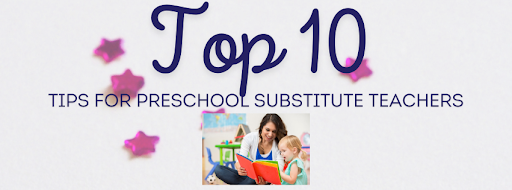
16 Aug 10 Substitute Teacher Teaching Tips
10 Substitute Teacher Teaching Tips
By Bonnie Piazza (about Bonnie)
As experts in the field of Early Childhood Education Substitute Teaching we have gathered out Top 10 Tips to help you be the BEST substitute teacher you can be. Here they are in no particular order:
Google Map Your Assignment:
Always always look up the address of where you will be going. Look at the directions based on the time of day you need to leave in order to arrive before your assignment starts so you can walk in on time. Some locations are on public school campuses or churches so you may need to look at the street view to find the best place to park and get to the preschool entrance.
Smile:
Walk in with a smile – always. It doesn’t matter what is happening in the office. It could be chaotic or calm, but everyone enjoys greeting a smiling face.
Paperwork Ready:
Unless you have been going to the same place on a long-term assignment, you will need to give the front office your agency paperwork. This will contain licensing documents that allow you to work at their facility. Have this ready to present rather than fumbling to find it in your purse or bag.
Ask Questions:
Be sure to ask about any special rules the program has and how you can best help in the assigned classroom that day. Once you arrive in the classroom ask the classroom teacher the same question about how you can best help them that day. Find out about ratios, classroom daily schedule, allergies and emergency exits.
Greet the Children:
As you enter the room acknowledge the children you see close by. Some may be curious and run right up to you. Stoop to their level and engage in conversation with them. Ask their name and tell them you are looking forward to spending the day with them.
Be Observant:
Position yourself so you can see the most children and areas in the classroom or playground. Once positioned you can engage with the children in your area while also glancing around the room to help with overall classroom management. This will help avoid conflicts from escalating while also looking for situations to praise or help create learning moments.
Be Flexible:
Often preschool programs who use substitute teachers need help in the floating teacher capacity or to support the lead teacher. That can look like many things such as serving and cleaning up snack time; sweeping the floor; changing diapers; running errands; preparing classroom materials; and giving breaks to other teachers to name a few.
Dress Appropriately:
If your agency has notes about your assignments dress code, look for those. If they don’t have them, ask. An additional step you could take is look up the website for the preschool you will be working with to see if you can determine the best way to dress. However, close-toed shoes are always safest. Be conservative in your style of dress is also a good best practice if you don’t know otherwise.
Take Initiative:
If you see a mess, clean it up. If two children are in conflict go help resolve it. Don’t know what to do, ask the lead teacher what you can do to help. Two of the biggest complaints our agency gets is teachers who stand around not engaging with the children or are checking their cellphone constantly. An easy are huge no nos. Easy solution to both is only check your cell phone on breaktimes and find something to do.
Be the Light:
Teaching in Early Childhood Education is rewarding, but it also comes with a lot of stressful days. When you arrive plan to be the reason the day was better for that program. You will be requested to go back time and time again and be seen as a ray of sunshine for those around you!



Sorry, the comment form is closed at this time.